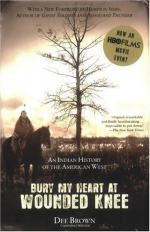|
This section contains 5,390 words (approx. 14 pages at 400 words per page) |

|
In the following essay, Fixico places Bury My Heart at Wounded Knee within the context of related works of its time, stressing its importance as the first work to humanize Native Americans for the general public.
In 1971 Dee Brown wrote Bury My Heart at Wounded Knee—a book that stunned America, persuading a generation to listen to the voice of Native Americans. Society learned about the Indian as a victim in the American West.
The full impact involved the emergence of an academic Indian voice in the following years. Native Americans had always expressed their concerns and opinions about issues ranging from legal status, to living conditions, to past mistreatment at the hands of the United States government. But the Indian voice was not widely heard, at least by the dominant society, until the 1960s during the Civil Rights protests and the concurrent rise of American...
|
This section contains 5,390 words (approx. 14 pages at 400 words per page) |

|




